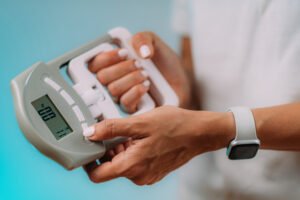Grip Dynamometer Test: Utilising a handgrip dynamometer, this test quantifies the maximum isometric strength of the hand and forearm muscles. It’s a straightforward, reliable measure that’s been correlated with overall body strength, serving as a powerful predictor of future health outcomes.
Dead Hang Test: This endurance-focused test measures how long an individual can hang from a bar with extended arms. It’s an effective way to assess upper body strength, grip endurance, and the functional status of the shoulder girdle. We regularly do this with our personal training clients in our London facility as a way to track improvements and have a functional workout.
Children and Adolescents: For children aged 6-12, grip strength progresses with age, showing a marked difference between sexes as they approach puberty. Boys tend to exhibit a slightly stronger grip than girls, with norms for a good grip strength ranging from 15-20 kg for boys and 13-17 kg for girls using the grip dynamometer. Adolescents experience a significant increase in grip strength, reflective of rapid growth and physical development.
Adults: Adult norms demonstrate peak physical capabilities, with men showing a good grip strength of 45-60 kg and women 30-42 kg on the dynamometer. These values signify optimal health and are crucial for physical job demands, sports performance, and daily activities.
Elderly: The elderly experience a decline in grip strength, emphasising its importance in predicting the risk of falls, functional decline, and the overall quality of life. For individuals over 60, maintaining a grip strength above the poor threshold (<27 kg for men and <15 kg for women) is associated with better health outcomes.
Here we have the grip chart that we use in the warrior for life booklet
Grip strength tests are important across various domains:
 Grip strength testing, through both the grip dynamometer and the dead hang test, offers critical insights into an individual’s health and functional ability. By understanding and applying normative data across age groups, health professionals can better assess, monitor, and intervene to improve health outcomes. As a reflection of overall well-being, grip strength remains a vital measure in the toolkit of healthcare providers, personal trainers, and researchers alike.
Grip strength testing, through both the grip dynamometer and the dead hang test, offers critical insights into an individual’s health and functional ability. By understanding and applying normative data across age groups, health professionals can better assess, monitor, and intervene to improve health outcomes. As a reflection of overall well-being, grip strength remains a vital measure in the toolkit of healthcare providers, personal trainers, and researchers alike.
At Evolve we’re super excited to be able to offer our own V02 Max testing facilities. Sign up below to be part of our trials and test out this advanced fitness testing technology completely free of charge. Just fill in your details and we’ll get back to you.
Evolve Gym 1 Cobb Street London E17LB
Email:
info@evolvefitness.co.uk
Phone:
020 8050 6956
Training Programmes
6 or 12 week intense transformation programme
The UK’s only group transformation programme
Training for longevity
Ongoing PT & Maintenance
1 month online intensive training course